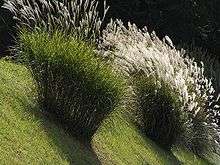Miscanthus
Miscanthus, or silvergrass,[4] is a genus of African, Eurasian, and Pacific Island plants in the grass family.[5][6]
- Miscanthus changii Y.N.Lee – Korea
- Miscanthus depauperatus Merr. – Philippines
- Miscanthus ecklonii (Nees) Mabb. – southern Africa
- Miscanthus floridulus – China, Japan, Southeast Asia, Pacific Islands
- Miscanthus fuscus (Roxb.) Benth. – Indian Subcontinent, Indochina, Pen Malaysia
- Miscanthus junceus – southern Africa
- Miscanthus lutarioriparius L.Liu ex S.L.Chen & Renvoize – Hubei, Hunan
- Miscanthus nepalensis (Trin.) Hack. – Indian Subcontinent, Tibet, Yunnan, Myanmar, Vietnam, Pen Malaysia
- Miscanthus nudipes (Griseb.) Hack. – Assam, Bhutan, Nepal, Sikkim, Tibet, Yunnan
- Miscanthus × ogiformis Honda – Korea, Japan
- Miscanthus oligostachyus Stapf. – Korea, Japan
- Miscanthus paniculatus (B.S.Sun) S.L.Chen & Renvoize – Guizhou, Sichuan, Yunnan
- Miscanthus sacchariflorus – Korea, Japan, northeastern China, Russian Far East
- Miscanthus sinensis – Korea, Japan, China, Southeast Asia, Russian Far East; naturalized in New Zealand, North + South America
- Miscanthus tinctorius (Steud.) Hack. – Japan
- Miscanthus villosus Y.C.Liu & H.Peng – Yunnan
- Miscanthus violaceus (K.Schum.) Pilg. – tropical Africa
- formerly included[3]
| Miscanthus | |
|---|---|
 | |
| Miscanthus sinensis | |
| Scientific classification | |
| Kingdom: | Plantae |
| Clade: | Tracheophytes |
| Clade: | Angiosperms |
| Clade: | Monocots |
| Clade: | Commelinids |
| Order: | Poales |
| Family: | Poaceae |
| Subfamily: | Panicoideae |
| Supertribe: | Andropogonodae |
| Tribe: | Andropogoneae |
| Subtribe: | Saccharinae |
| Genus: | Miscanthus Andersson |
| Type species | |
| Miscanthus capensis | |
| Synonyms[3] | |
| |
see Chloris, Pseudopogonatherum, Saccharum, and Spodiopogon
- Miscanthus affinis – Pseudopogonatherum quadrinerve
- Miscanthus cotulifer – Spodiopogon cotulifer
- Miscanthus polydactylos – Chloris elata
- Miscanthus rufipilus – Saccharum rufipilum
- Miscanthus tanakae – Pseudopogonatherum speciosum
References
- lectotype designated by Coville, Contr. U.S. Natl. Herb. 9: 400 (8 Apr 1905)
- Tropicos, Miscanthus Andersson
- Kew World Checklist of Selected Plant Families
- "Miscanthus". Natural Resources Conservation Service PLANTS Database. USDA. Retrieved 13 July 2015.
- Andersson, Nils Johan. 1855. Öfversigt af Förhandlingar: Kongl. Svenska Vetenskaps-Akademien 12: 165.
- Flora of China Vol. 22 Page 581 芒属 mang shu Miscanthus Andersson, Öfvers. Kongl. Vetensk.-Akad. Förh. 12: 165. 1855.
- The Plant List search for Miscanthus
- "Recent classification work at the Royal Botanic Gardens at Kew, England has designated it as M. x giganteus […], a hybrid of M. sinensis […] and M. sacchariflorus […]."
Eric Anderson, Rebecca Arundale, Matthew Maughan, Adebosola Oladeinde, Andrew Wycislo & Thomas Voigt (2011) Growth and agronomy of Miscanthus x giganteus for biomass production, Biofuels, 2:1, page 71. https://doi.org/10.4155/bfs.10.80

- «M. x giganteus is a highly productive, sterile, rhizomatous C4 perennial grass that was collected in Yokahama, Japan in 1935 by Aksel Olsen. It was taken to Denmark where it was cultivated and spread throughout Europe and into North America for planting in horticultural settings.»
Eric Anderson, Rebecca Arundale, Matthew Maughan, Adebosola Oladeinde, Andrew Wycislo & Thomas Voigt (2011) Growth and agronomy of Miscanthus x giganteus for biomass production, Biofuels, 2:1, page 71. https://doi.org/10.4155/bfs.10.80

- «The majority of the literature reporting dry biomass yield for M. x giganteus originates from European studies. Ceiling peak biomass yields in established stands of M. x giganteus have approached 40 t dry matter (DM) ha-1 in some European locations, although it may take 3–5 years to achieve these ceiling yields [84]. Across Europe, harvestable yields of up to 25 t DM ha-1 from established stands of M. x giganteus have been reported in areas between central Germany and southern Italy, while peak yields in central and northern Europe have ranged between 10–25 t DM ha-1, and in excess of 30 t DM ha-1 in southern Europe [3]. A quantitative review of established M. x giganteus stands across Europe reported a mean peak biomass yield of 22 t DM ha-1, averaged across N rates and precipitation levels [1].» Eric Anderson, Rebecca Arundale, Matthew Maughan, Adebosola Oladeinde, Andrew Wycislo & Thomas Voigt (2011) Growth and agronomy of Miscanthus x giganteus for biomass production, Biofuels, 2:1, page 79. https://doi.org/10.4155/bfs.10.80

- «Field experiments with the only genotype currently commercially available, Miscanthus x giganteus, a clone-based interspecies hybrid, have revealed its great photosynthetic efficiency, high biomass yield capacity, low input demands and good tolerance of temperate climates, and many of the characteristics that make miscanthus an ideal biomass crop.» Lewandowski I, Clifton-Brown J, Trindade LM, van der Linden GC, Schwarz K-U, Müller-Sämann K, Anisimov A, Chen C-L, Dolstra O, Donnison IS, Farrar K, Fonteyne S, Harding G, Hastings A, Huxley LM, Iqbal Y, Khokhlov N, Kiesel A, Lootens P, Meyer H, Mos M, Muylle H, Nunn C, Özgüven M, Roldán-Ruiz I, Schüle H, Tarakanov I, van der Weijde T, Wagner M, Xi Q and Kalinina O (2016) Progress on Optimizing Miscanthus Biomass Production for the European Bioeconomy: Results of the EU FP7 Project OPTIMISC. Frontiers in Plant Science 7:1620. https://doi.org/10.3389/fpls.2016.01620

- Blog of Centre for Alternative Technology in Wales: "The world’s first Miscanthus bale house". Retrieved 2017-11-27
External links
- UK's National Centre for Biorenewable Energy, Fuels and Materials
- Miscanthus x giganteus - as an energy crop - Miscanthus Research at the University of Illinois
This article is issued from Wikipedia. The text is licensed under Creative Commons - Attribution - Sharealike. Additional terms may apply for the media files.